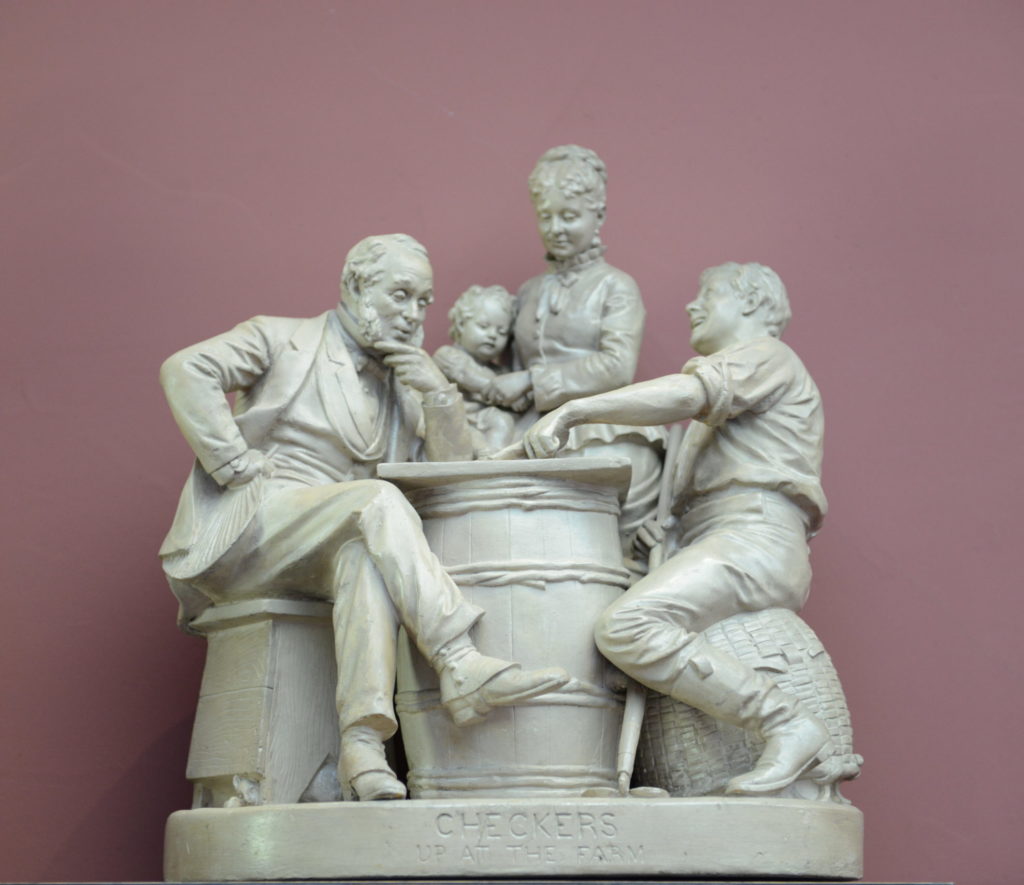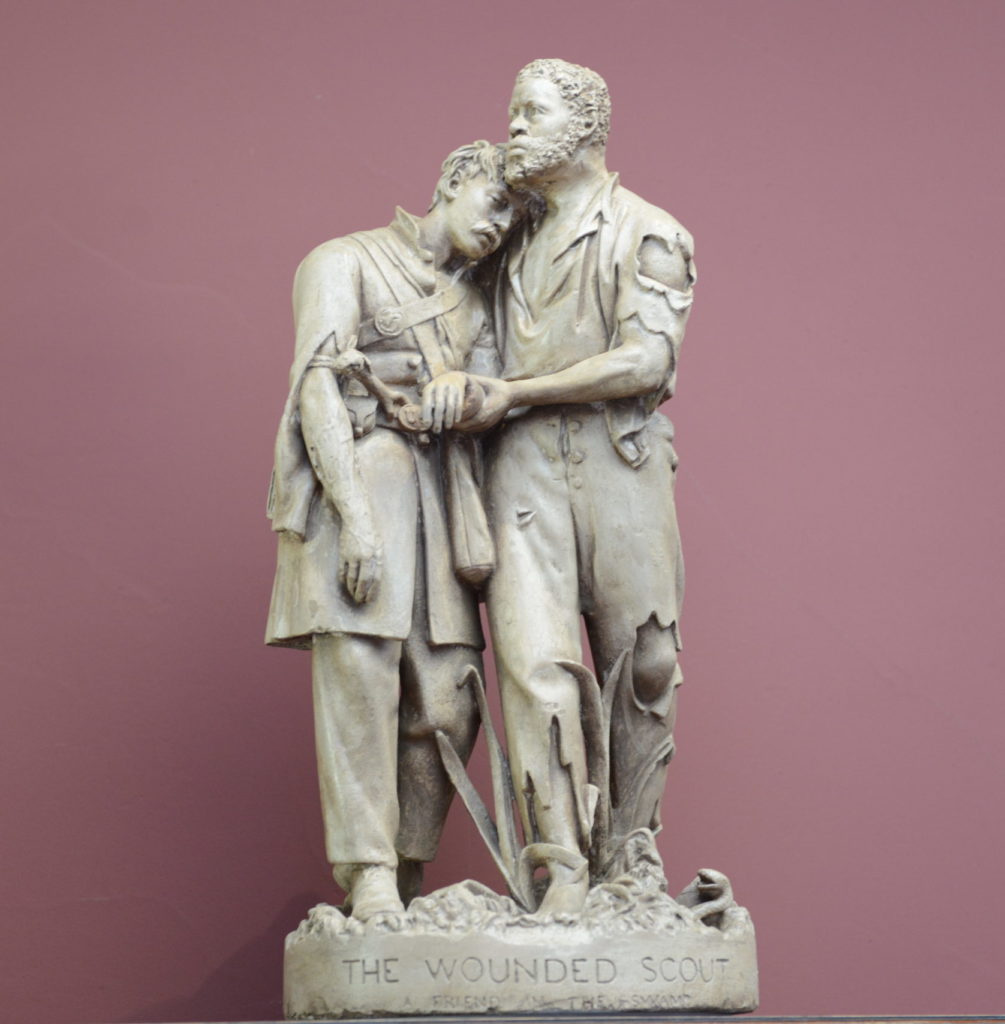
John Rogers Jr., “Checkers up at the Farm,” 1875. photo: Harris Walker, New Canaan Museum & Historical Society
By Nancy Geary
(c) Connecticut Explored Inc. Winter 2019-2020
Subscribe/Buy the Issue!
John Rogers Jr. (1829 – 1904) may be the most popular sculptor in United States history you’ve never heard of. According to David Wallace in his seminal biography, John Rogers, The People’s Sculptor (Wesleyan University Press, 1967), between 1860 and 1893, when Rogers worked as a professional artist, Americans purchased approximately 80,000 of his putty-colored plaster “Rogers Groups” at an average price of $14. These realistic works, which celebrated military, theatrical, and domestic scenes, were fixtures in nearly every Victorian parlor. Wallace asserts, “No other American sculptor has ever been so completely at one with his contemporaries in taste, in spirit, and in human sympathies, and none has made his works so generally available to the general public.”
Rogers and his family moved to New Canaan, Connecticut in 1897. He was born in Salem, Massachusetts in 1829, the son of a Boston merchant and an heir to a shipping empire whose family fortune had dissipated. His father had his own series of disastrous forays into business. John Jr. studied mathematics, mechanics, and surveying. He worked as a dry-goods clerk, a master mechanic, and a city surveyor.
Rogers discovered his love of art on April 2, 1849. While he was suffering from a persistent eye infection that threatened to end his career as a civil engineer, a friend showed him a small clay figure he had just purchased. Rogers was smitten. He bought some clay and molded his first figure. He could do the work despite his vision problem, and, as he noted in his diary, he, “found it a great resource and enjoyment.”
Ten years later, while working as a city surveyor in Chicago, he was asked to make a clay group to raffle off at a charity bizarre. His creation, Checkers Players, was a success and led to several commissions. When he lost his surveying job due to the declining economy, his career as a sculptor was born.
Rogers settled in New York City in November 1859 and got to work. He wanted to do something that no artist, with the notable exception of the printmakers Currier and Ives, had done: to develop a national market for a luxury product. As Michael Leja explains in his essay, “Sculpture for a Mass Market” in John Rogers: American Stories (Philip Wilson Publishers, 2010), Rogers was poised to achieve this goal because he “had a more intimate familiarity with the new processes of industrial production than most of his artist colleagues.” His success depended on both an inexpensive, fast production process and a sales force—which included in one instance hiring an African-American agent to sell his Slave Auction sculpture to abolitionists. He experimented with a variety of media but, in 1863, decided plaster would enable him to produce low-cost statuary and to focus on marketing his work to the average homeowner.
Rogers largely rejected neoclassicism and the elitism of its allegorical and philosophical themes of the ideal that was so popular at the time in Europe. Influenced in large part by the Scottish genre painter Sir David Wilkie, Rogers portrayed a variety of occupations and levels of society. He captured humble life and popular subjects such as Weighing the Baby—each imbued with his sense of sentimentality and light comedy. As Wallace notes, “Humor was an important element in Rogers’ popularity … it [was]essentially schoolboy humor, drawn from experience, obvious enough for all to understand, and innocent enough for all to enjoy.”

John Rogers Jr., “The Wounded Scout: A Friend in the Swamp,” 1865. photo: Harris Walker, New Canaan Museum & Historical Society
Rogers was a fierce abolitionist and defender of President Abraham Lincoln. In 1863 he gave Lincoln Wounded Scout: A Friend in the Swamp, a statue of a fugitive enslaved man supporting an injured Union soldier. In a letter of thanks, Lincoln remarked that it was “very pretty” and added, “I should think an excellent piece of art.” After Lincoln’s assassination, Rogers produced versions of The Council of War, which Lincoln’s eldest son, Robert Todd Lincoln, pronounced the best likeness of his father ever created. In 1893 Rogers’s finest monumental work, also depicting Abraham Lincoln, won a bronze medal at the World’s Columbian Exposition in Chicago.
Rogers kept a weekend home on Oenoke Ridge in New Canaan. Some of his works reflect the joy of country living and his nostalgia for the carefree days of childhood. He had a studio built in 1878—designed by the renowned Boston architecture firm of Peabody & Stearns—a small Victorian building with an enormous skylight. In 1897 Rogers and his family moved permanently to New Canaan, where he remained for the rest of his life.
The house has since been demolished, but the New Canaan Historical Society was able to preserve his studio. It was moved onto the society’s campus in 1965 and was designated by the United States Department of the Interior as a National Historic Landmark for its exceptional ability to illustrate United States heritage. A substantial collection of Rogers’s work remains on permanent display in this studio-museum.
Nancy Geary is executive director of New Canaan Historical Society.
Explore!
New Canaan Museum & Historical Society
13 Oenoke Ridge, New Canaan
nchistory.org
 Connecticut Explored received support for this publication from the State Historic Preservation Office of the Department of Economic and Community Development with funds from the Community Investment Act of the State of Connecticut.
Connecticut Explored received support for this publication from the State Historic Preservation Office of the Department of Economic and Community Development with funds from the Community Investment Act of the State of Connecticut.
